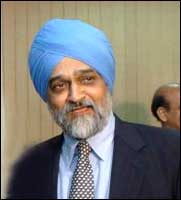|
|
| Help | |
| You are here: Rediff Home » India » Business » Interviews » Montek Singh, Planning Commission Deputy Chairman |
|
| ||||||||||||||||||||||||||||||||||||||||||||
|
| ||||||||||||||||||||||||||||||||||||||||||||
Planning Commission Deputy Chairperson Montek Singh Ahluwalia talks about his favourite topic, infrastructure funding, in the first of a two-part interview with Mamata Singh.
Excerpts:
Fears have been raised in many quarters over the excessive inflow of foreign exchange into the country. The way the special purpose vehicle has been structured, it is unlikely to use much of the reserves either.
If the country is deluged with people wanting to pick up financial assets from the country, there are a number of ways of handling it.

One option will be to let the money flow in and not sterilise it. If people do not want to use forex, the rupee can be allowed to appreciate. But this idea is likely to be opposed.
Another option is not to sterilise the inflows, protect the impact on the exchange rate, cut Customs duty and encourage imports. This has been done to an extent in the Budget. Of course, you would also remove controls on capital outflows.
These options are sensible, but they will have to be done gradually. The alternative is to invest in infrastructure that can be pushed up steeply.
In my view, the inflows should go into infrastructure. The ideal way will be to sterilise the inflow, build reserves and push liquidity into system. If banks do not know who to lend to, we can pump in directed demand.
The country needs a lot of infrastructure. The SPV is a mechanism to channel money to finance infrastructure projects. If there is too much liquidity, the SPV can mop up the extra amount and use it to finance projects. Lack of projects is a problem, but that is more because the effort has not been made to identify them. Rs 10,000 crore (Rs 100 billion) could easily be used.
As the process is kicked off and there is more demand, there is nothing stopping the government from raising the limit. If the National Urban Renewal Mission is to come through, and even if two mega cities are serious about putting in place major investments, the demand can go beyond Rs 10,000 crore.
The way the SPV has been structured, it is a conscious decision not to give money to ministries in their budgets. They will have to come up with projects.
The part of a project that will require normal debt will have to be appraised by financial institutions. This is meant for roads, railways and states (urban infrastructure). It will take them time to get ready and gear up to the system.
The existing public sector system is so used to getting money from the Budget, they cannot prepare a good project for scrutiny by financial institutions. Rs 10,000 crore is a reasonable limit, but if momentum builds up, we can go beyond the limit.
However, if constraints to the mechanism do not allow going beyond that level and inflows keep building up, a decision will have to be taken on other options.
What steps are being taken in order to attract more investment to infrastructure sectors?
There is no doubt that in order to bring about the involvement of the private sector in many of the infrastructure sectors, we need basic new initiatives.
Some of them are reforms of the policy framework and the regulatory system. A lot of them are connected with having clarity on the concession agreements and terms of operations.
Our experience is that if you do not get the terms of operation and concession agreements clarified, you end up with an investment activity that moves in a way that later on seems to be not quite right. We do not have much experience in doing this.
Also, there is no mechanical 'best way' of doing this. International experience is varied. In each case there is a good and a bad outcome. Judgments are involved. In the case of airports, we are working on a model concession agreement that can become a model for all privatisation efforts.
At the same time we are working with the ministry concerned to get the draft concession agreement for Mumbai and Delhi airports as close to what we think is 'perfection'.
Similarly, in the case of roads we want a lot of them to be built in the build-operate-transfer mode, where private investors bring in their money. The concession agreement that will guide the terms of operation has to be ideally drafted. We are trying to develop an ideal concession agreement there also.
The Planning Commission is also looking at the ideal regulatory structures required in various sectors.
We are working on a paper on regulatory framework in which we will look at the regulatory structures in different sectors and give some sense of whether they correspond to the best practices.
The regulatory structure is important, but it will take many years for a truly credible regulatory structure to come up. It is a matter of law and its interpretation.
Everything can be challenged in courts and it is only over time that we will have achieved a settled law in the process.
Even with a not-so-good regulatory system, if you have a concession agreement, which is better, you can end up with a better result. But with a good regulatory structure and a bad concession agreement, the outcome can be bad.
Part II: 'States could borrow 30% from the market'
More Interviews
|
|
| © 2008 Rediff.com India Limited. All Rights Reserved. Disclaimer | Feedback |